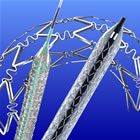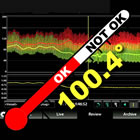 At this week’s annual European Society of Cardiology Congress in Rome, an important randomized clinical trial on stents was presented by Professor Kaare H. Bønaa, MD, PhD of the Clinic for Heart Disease, St. Olav’s University Hospital in Trondheim, Norway. Called NORSTENT, short for the “Norwegian Coronary Stent Trial,” this was the largest stent trial ever conducted, with 9,013 patients followed for six years. That’s serious! Continue reading
At this week’s annual European Society of Cardiology Congress in Rome, an important randomized clinical trial on stents was presented by Professor Kaare H. Bønaa, MD, PhD of the Clinic for Heart Disease, St. Olav’s University Hospital in Trondheim, Norway. Called NORSTENT, short for the “Norwegian Coronary Stent Trial,” this was the largest stent trial ever conducted, with 9,013 patients followed for six years. That’s serious! Continue reading
Category Archives: Media Coverage
“A Type of Interventional Radiology”: A Quaint Memory from the New York Times
 I recently was rifling through some old files of news clippings (you remember those pesky things, don’t you?) and came across a major New York Times Magazine feature from 1983. It was titled, “Toward the Conquest of Heart Disease.”
I recently was rifling through some old files of news clippings (you remember those pesky things, don’t you?) and came across a major New York Times Magazine feature from 1983. It was titled, “Toward the Conquest of Heart Disease.”
Three decades ago, as the article describes, the main treatments were surgical: valve replacement and the “far more complicated, technically demanding” bypass graft surgery. The author, Harry Schwartz, also identifies some exciting new advances in heart disease treatment: artificial hearts, heart transplants, new drugs, something called nuclear magnetic resonance (N.M.R.) that was “being used in a handful of hospitals” (today we call it MRI!). Continue reading
Filed under History, Media Coverage
Consumer Reports Overstates Cardiac CT Radiation Dose
 Consumer Reports regularly publishes health information to aid the consumer/patient in making decisions. And that’s a good thing. But also important is having the most current information, which their January 27, 2015 article, titled “The surprising dangers of CT scans and X-rays,” does not.
Consumer Reports regularly publishes health information to aid the consumer/patient in making decisions. And that’s a good thing. But also important is having the most current information, which their January 27, 2015 article, titled “The surprising dangers of CT scans and X-rays,” does not.
All of the cautions about imaging tests that are listed in the Consumer Reports article are valid: ask why the test is necessary; check the credentials of the imaging specialist; ask for the lowest effective dose; avoid unnecessary repeat scans.
But one important piece of data is almost a decade old and, as a result, is potentially misleading. I’m talking about the radiation dose from a Cardiac CT scan. The article states that a Cardiac CT Angiogram (CTA) exposes the patient to 12 mSv of ionizing radiation, or 120 times that of a chest X-ray. This was true years ago, when CTA was first being used to diagnose coronary artery disease. But it is not true today. Continue reading
Filed under Cardiac CT, Imaging, Media Coverage, Non-Invasive Testing
Who’s Sorry Now? The ABIM, That’s Who
 The lyrics of the 1923 song go like this: “Who’s sorry now, who’s sorry now? / Whose heart is achin’ for breakin’ each vow?”
The lyrics of the 1923 song go like this: “Who’s sorry now, who’s sorry now? / Whose heart is achin’ for breakin’ each vow?”
And today, it was the American Board of Internal Medicine (ABIM) who said they were sorry for breaking the hearts of all the cardiologists in the U.S. of A.
They wrote specifically: “We got it wrong and sincerely apologize. We are sorry.” Continue reading
Filed under ACC, Media Coverage, Medical Education, SCAI
From Bench to Bedside to Bench Revisited: Supreme Court Justice Ginsburg Back in Action
 Almost two decades ago, interventional cardiology pioneer Dr. Spencer B. King III penned an article for Circulation titled, “Angioplasty From Bench to Bedside to Bench.” Dr. King’s article was a recounting of the history of the development of the angioplasty balloon catheter by his colleague at Emory University, Andreas Gruentzig.
Almost two decades ago, interventional cardiology pioneer Dr. Spencer B. King III penned an article for Circulation titled, “Angioplasty From Bench to Bedside to Bench.” Dr. King’s article was a recounting of the history of the development of the angioplasty balloon catheter by his colleague at Emory University, Andreas Gruentzig.
This morning, the title of his article took on new meaning, as Supreme Court Justice Ruth Bader Ginsburg entered the courtroom and took her seat, engaging in several complex legal arguments concerning mortgage loan officers, Facebook threats, and more. Continue reading
Filed under Celebrity Patients, History, Media Coverage, Stent
Fractional Flow Reserve and Ebola: Thresholds and Decision-Making
 This week started off with me watching a demonstration of fractional flow reserve (FFR) during multivessel PCI. This very instructive case was transmitted live from Hammersmith Hospital in London and featured Dr. Justin E. Davies showing how to perform FFR and, more importantly, how the use of FFR changed the treatment plan for this patient.
This week started off with me watching a demonstration of fractional flow reserve (FFR) during multivessel PCI. This very instructive case was transmitted live from Hammersmith Hospital in London and featured Dr. Justin E. Davies showing how to perform FFR and, more importantly, how the use of FFR changed the treatment plan for this patient.
The angiogram had shown three intermediate blockages (LAD, OM, RCA) and, as such, this patient might have been a candidate for CABG instead of PCI. However, when FFR was used to measure whether or not these blockages were ischemic, two were found to be hemodynamically insignificant: it would be safe to defer stenting and treat them medically. The third lesion in the LAD clearly was the cause of the symptoms and stenting would have benefit for the patient. Continue reading
Filed under Appropriate Use Criteria (AUC), FAME I / FAME II, FFR, Media Coverage, Stent, Video
Will a Denial of Service DOS Attack Hit New York State Medicaid Patients? Or Perhaps Your State?
 What does a Denial of Service Attack have to do with stents, angioplasty and PCI?
What does a Denial of Service Attack have to do with stents, angioplasty and PCI?
In the world of computing, a DOS attack is defined as “an attempt to make a machine or network resource unavailable to its intended users.” Typically netbots programmed by hackers overwhelm the web servers of banks, credit card providers, etc. whose sites then become unavailable to their customers. Now it seems similarly that in New York State, cardiovascular treatments may become unavailable to some Medicaid patients: a denial of service. Continue reading



